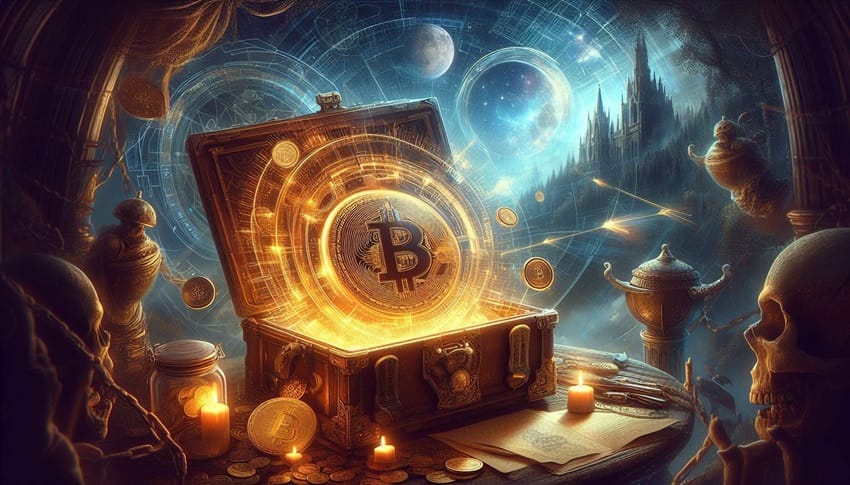The Future of Bitcoin Scarcity: Will the Finite Supply Still Matter in 2140?
Bitcoin, often referred to as digital gold, has a finite supply capped at 21 million coins, a limit expected to be reached by the year 2140. Unlike other assets, the supply of Bitcoin cannot be increased by any form of central authority, making it unique in the financial world. This article explores the implications of this scarcity, the impact on miners and investors, and the future of Bitcoin in an ever-evolving economic and technological landscape.
Key Takeaways
- Bitcoin’s finite supply of 21 million coins is expected to be fully mined by 2140, making it an asset with absolute scarcity.
- The inability to increase Bitcoin’s supply could enhance its intrinsic value, similar to precious metals like gold.
- Post-2140, Bitcoin miners will rely on transaction fees as their primary source of income, which could impact the network’s security and efficiency.
- The fixed supply of Bitcoin may lead to increased price volatility, influenced by supply and demand dynamics.
- Technological advancements and regulatory changes will play crucial roles in shaping Bitcoin’s future use cases and market behavior.
The Concept of Bitcoin Scarcity
Understanding Finite Supply
Bitcoin’s scarcity is a revolutionary concept in the digital age. Unlike traditional commodities, Bitcoin achieves absolute scarcity. There will only ever be 21 million Bitcoin, a fixed quantity that cannot be increased. This is a stark contrast to physical goods, where scarcity is relative and can be influenced by factors like production efforts and time.
Comparison with Precious Metals
When comparing Bitcoin to precious metals like gold, it’s important to note that while gold is considered scarce, it is not absolutely scarce. The supply of gold can increase with new discoveries and mining technologies. Bitcoin, however, remains fixed at 21 million units, making it a unique digital asset with a predictable supply.
Intrinsic Value Implications
The intrinsic value of Bitcoin is closely tied to its scarcity. As demand for Bitcoin increases and the supply remains fixed, the value of each Bitcoin is likely to rise. This dynamic is governed by the law of supply and demand, which is a fundamental principle of economics. The concept of Bitcoin’s scarcity also positions it as a potential hedge against aggressive inflation in the US market in 2024 and beyond.
Bitcoin’s absolute scarcity sets it apart from all other assets, digital or physical. This unique characteristic underpins its value proposition and potential as a long-term store of value.
Bitcoin Mining and the 21 Million Cap
Mining Process Overview
Bitcoin mining is the process by which new bitcoins are created and added to the Blockchain, a decentralized ledger that records all Bitcoin transactions. As more bitcoins are mined, the rate at which new bitcoins are created is gradually reduced. This is because the Bitcoin protocol includes a mechanism known as halving, which reduces the block rewards over time. Block rewards are part of the blockchain’s automatic process of validating transactions and opening new blocks.
Impact on Miners Post-2140
When all 21 million bitcoins have been mined, no more bitcoins can be created. This means that the supply of Bitcoin will be fixed at 21 million, and the value of Bitcoin will be determined entirely by supply and demand. However, the reality is likely to be more complex than this. Miners will need to adapt to a new economic model where transaction fees become their primary source of revenue.
The 21 million Bitcoin limit also has important implications for the process of Bitcoin mining. Miners, participants who compete to validate transactions, will face a significant shift in their revenue structure post-2140.
Transaction Fees as Incentives
As the block rewards diminish, transaction fees will become increasingly important for miners. These fees will serve as incentives for miners to continue validating transactions and maintaining the network. The transition to a fee-based model will be crucial for the sustainability of the Bitcoin network in the long term.
- Miners will rely more on transaction fees.
- The competition for transaction validation may increase.
- The overall security of the network will depend on these incentives.
Economic Implications of Bitcoin’s Finite Supply
Supply and Demand Dynamics
Bitcoin’s finite supply of 21 million coins is a fundamental principle that drives its economic value. As of now, over 19 million bitcoins have been mined, leaving less than 2 million to be created. This scarcity can lead to a supply crunch, potentially causing its price to appreciate. Several factors determine what gives a bitcoin its value, including supply and demand, forks, competition, and regulations.
Price Volatility
The limited supply of Bitcoin can lead to significant price volatility. When fewer bitcoins are available, demand can rise, increasing the price. However, if demand doesn’t grow, prices may stay the same or drop. This volatility is a double-edged sword for investors, offering both high reward and high risk.
Long-term Value Proposition
The long-term value proposition of Bitcoin is closely tied to its finite supply. By limiting the supply of bitcoins, the value of each individual Bitcoin is theoretically increased. This is because as demand for Bitcoin increases, but the supply remains fixed, the price of Bitcoin is likely to increase as well. This principle is akin to precious metals with limited supplies, which help give them more intrinsic value.
A fixed money supply, or a supply altered only in accord with objective and calculable criteria, is a necessary condition to a meaningful just price of money.
Technological Evolution and Bitcoin’s Future
Network Upgrades
Bitcoin’s environment is still evolving, and network upgrades are essential to ensure its longevity and efficiency. Over the next decade, we can expect significant improvements in the Bitcoin protocol, focusing on security, speed, and scalability. These upgrades will be crucial in maintaining the network’s robustness and reliability.
Scalability Solutions
Scalability remains one of Bitcoin’s most pressing challenges. Solutions like the Lightning Network aim to address this by enabling faster and cheaper transactions. As these technologies mature, they will play a pivotal role in Bitcoin’s ability to handle increased transaction volumes without compromising performance.
Potential Use Cases
The evolving landscape of Bitcoin offers a fascinating glimpse into the future of finance. Beyond being a store of value, Bitcoin may find applications in various sectors, including supply chain management, digital identity verification, and smart contracts. The potential use cases are vast, and as the technology matures, we may see Bitcoin integrated into everyday transactions and business operations.
In the year 2140, will Bitcoin work similarly to cash or gold bars? Bitcoin’s environment is still evolving, so it’s feasible, if not likely, that it will continue to evolve over the next few decades.
Investor Perspectives on Bitcoin Scarcity
Bitcoin’s finite supply has always been a significant driver of market sentiment. Investors often view Bitcoin as a hedge against inflation and a store of value, similar to precious metals. The concept of absolute scarcity, where only 21 million Bitcoin will ever exist, adds to its allure. Understanding key drivers behind Bitcoin’s value, such as its scarcity, is crucial for making informed investment decisions.
Diversifying during the intriguing Bitcoin bull run in 2024 is crucial for maximum gains. Investors should spread investments, avoid risks, and understand key drivers for stable returns. Some strategies include:
- Long-term holding (HODLing)
- Dollar-cost averaging (DCA)
- Allocating a small percentage of the portfolio to Bitcoin
Given Bitcoin’s inherent volatility, risk management is essential. Investors should be aware of the potential for significant price swings and plan accordingly. This includes setting stop-loss orders, regularly reviewing investment portfolios, and staying informed about market trends.
In the ever-evolving landscape of cryptocurrency, staying informed and adaptable is key to navigating the risks and rewards of Bitcoin investment.
Regulatory and Legal Considerations
Governments worldwide have grappled with how to classify and regulate Bitcoin. Some view it as a currency, others as property, and still others as a commodity. These distinctions matter, as they affect taxation, reporting, and legality.
Mining and holding Bitcoin also come with legal considerations. Miners, who verify transactions and secure the network, may need to register as businesses and comply with local regulations. For Bitcoin holders, the key concern is legal ownership.
As Bitcoin’s popularity continues to grow, governments are actively shaping their regulatory stances. Here are a few potential scenarios:
- Mining Regulations: Miners often consume substantial electricity. In some regions, governments impose regulations to ensure energy conservation and prevent adverse environmental impacts.
- Tax Reporting: Bitcoin transactions can trigger capital gains taxes. Holders must track and report transactions accurately to avoid legal trouble and potential fines.
- Asset Forfeiture Laws: In cases of illegal activities involving Bitcoin, authorities may seize assets. This underscores the importance of legal compliance.
- Classification Variability: Governments worldwide classify Bitcoin differently. For example, Japan recognizes it as legal tender, while India has considered banning it altogether. This lack of uniformity leads to varying regulations and tax treatments.
- AML and KYC Regulations: Anti-Money Laundering (AML) and Know Your Customer (KYC) regulations require exchanges and businesses to verify user identities and monitor transactions for suspicious activity.
As Bitcoin continues to evolve, the regulatory landscape will likely become more complex, requiring stakeholders to stay informed and adaptable.
Bitcoin as Digital Gold
Store of Value
Bitcoin is often viewed as “digital gold” due to its finite supply of 21 million coins. This scarcity is a fundamental aspect that underpins its value. Unlike gold, Bitcoin excels in divisibility, portability, and stability, making it a superior store of value in the digital age. Unlocking the power of Bitcoin as a store of value is crucial for financial security.
Hedge Against Inflation
Bitcoin’s fixed supply makes it an effective hedge against inflation. As traditional currencies lose value due to inflationary pressures, Bitcoin’s scarcity ensures it retains value over time. This characteristic is particularly appealing in economies experiencing high inflation rates.
Comparisons to Traditional Assets
When compared to traditional assets like gold and real estate, Bitcoin stands out due to its absolute scarcity. While gold and real estate are limited by physical constraints, Bitcoin’s supply is capped at 21 million, making it the only asset with a set fixed quantity. This unique feature positions Bitcoin as a revolutionary asset in the financial world.
Bitcoin’s versatility, superiority to gold, and resilience highlight its potential as a long-term investment. Embrace Bitcoin for financial security in the digital age.
Bitcoin has often been likened to digital gold due to its limited supply and store of value properties. As the world increasingly turns to digital assets, understanding Bitcoin’s role becomes crucial. Dive deeper into the world of Bitcoin and other cryptocurrencies by visiting our website. Stay informed and ahead of the curve with our expert analysis and market updates.
Conclusion
As we look towards the year 2140, the finite supply of Bitcoin remains a pivotal aspect of its identity and value proposition. With a hard cap of 21 million coins, Bitcoin stands as a unique asset in the financial landscape, embodying absolute scarcity in a way that no other asset does. This scarcity is expected to drive demand and potentially increase its value, much like precious metals. However, the implications of reaching this supply limit will be multifaceted, affecting not just miners but also investors and the broader financial ecosystem. While the future of Bitcoin’s role—whether akin to digital gold or a new form of currency—remains uncertain, its finite supply will undoubtedly continue to be a critical factor in its evolution and valuation.
Frequently Asked Questions
What is the maximum supply of Bitcoin?
The maximum supply of Bitcoin is capped at 21 million coins, which is expected to be fully mined by the year 2140.
Why does Bitcoin have a finite supply?
Bitcoin was designed with a finite supply to mimic the scarcity of precious metals like gold, thereby giving it intrinsic value and protecting it from inflation.
How is Bitcoin’s scarcity different from other assets?
Unlike other assets, Bitcoin’s supply cannot be increased by any central authority, decree, or vote. This absolute scarcity makes it unique among other financial assets.
What happens when all 21 million Bitcoins are mined?
Once all 21 million Bitcoins are mined, no new coins will be created. Miners will then earn rewards solely from transaction fees for verifying transactions on the network.
How does Bitcoin’s finite supply affect its price?
Bitcoin’s finite supply can lead to increased demand as fewer coins are available, potentially driving up the price. However, this can also lead to price volatility.
Will Bitcoin still be valuable in 2140?
While it’s difficult to predict the future, Bitcoin’s absolute scarcity and evolving use cases suggest that it could continue to hold value. However, its future value will depend on various factors including technological developments and market dynamics.
Stay informed with daily updates from Blockchain Magazine on Google News. Click here to follow us and mark as favorite: [Blockchain Magazine on Google News].
Get Blockchain Insights In Inbox
Stay ahead of the curve with expert analysis and market updates.
latest from tech
Disclaimer: Any post shared by a third-party agency are sponsored and Blockchain Magazine has no views on any such posts. The views and opinions expressed in this post are those of the clients and do not necessarily reflect the official policy or position of Blockchain Magazine. The information provided in this post is for informational purposes only and should not be considered as financial, investment, or professional advice. Blockchain Magazine does not endorse or promote any specific products, services, or companies mentioned in this posts. Readers are encouraged to conduct their own research and consult with a qualified professional before making any financial decisions. The featured image used is just a creative depiction of the title and it does not intend to hurt sentiments of any person or institution. If it hurts anyone sentiments, please do not hesitate to reach out to Blockchain Magazine.

 Bitcoin
Bitcoin  Ethereum
Ethereum  XRP
XRP  Tether
Tether  Solana
Solana  Dogecoin
Dogecoin  USDC
USDC  Cardano
Cardano  Lido Staked Ether
Lido Staked Ether  TRON
TRON  Chainlink
Chainlink  Avalanche
Avalanche  Wrapped stETH
Wrapped stETH  Wrapped Bitcoin
Wrapped Bitcoin  Stellar
Stellar  Sui
Sui  Hedera
Hedera  Toncoin
Toncoin  Shiba Inu
Shiba Inu  WETH
WETH  Polkadot
Polkadot  Parkcoin
Parkcoin  Litecoin
Litecoin  LEO Token
LEO Token  Bitcoin Cash
Bitcoin Cash  Bitget Token
Bitget Token  Uniswap
Uniswap  Hyperliquid
Hyperliquid  Official Trump
Official Trump  Wrapped eETH
Wrapped eETH  Pepe
Pepe  USDS
USDS  NEAR Protocol
NEAR Protocol  Ethena USDe
Ethena USDe  Aave
Aave  Aptos
Aptos  Internet Computer
Internet Computer  Ondo
Ondo  WhiteBIT Coin
WhiteBIT Coin  Ethereum Classic
Ethereum Classic  Monero
Monero  POL (ex-MATIC)
POL (ex-MATIC)  Mantle
Mantle  Cronos
Cronos  Algorand
Algorand  OKB
OKB  Render
Render  Dai
Dai 




